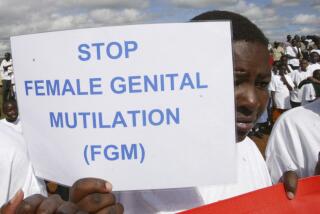A horrific practice
- Share via
FEMALE GENITAL mutilation -- not “female circumcision,” a comforting euphemism -- is one of the world’s most entrenched and pervasive violations of human rights. Each year an estimated 2 million women and girls, mostly in sub-Saharan Africa, Egypt and Sudan, are cut, typically before their 14th birthday.
But in the past few years, thousands of villages in Senegal, Egypt and Sudan have abandoned the practice. Some human rights advocates believe that a tipping point is at hand -- if the momentum against the practice, spurred on by the work of many government-supported agencies and nongovernmental organizations in Africa and around the world, continues.
The practice of removing all or part of girls’ external genitals has endured for a variety of reasons. It is believed to preserve a girl’s chastity by curbing her sexual drive. It confers marriageable status on girls who otherwise would be shunned. And it celebrates girls’ coming of age.
In many respects it is similar to foot-binding in China. Both practices, notes Gerald Mackie, a professor of political science at UC San Diego, existed for the same reasons: to keep women subjugated and thus marriageable. So the same strategy used to end foot-binding in China at the turn of the 20th century -- communitywide abandonment -- should also work today in Africa.
Instead of abandoning the practice of mutilation, some parents are taking their girls to trained medical personnel for operations. In addition, the age at which girls are cut is getting younger.
The programs most successful at ending the practice often run counter to Western sensibilities. Punishment, moral indignation and shaming are least effective. Building strong organizations at the village level, offering health and literacy education and addressing regional poverty -- especially in ways that strengthen women’s economic positions -- work best. In Senegal, an organization called Tostan (“breakthrough”), has pioneered these methods, and 1,993 of the country’s 5,000 villages have abandoned the practice. But change is slow. The group’s mostly Senegalese and Ghanaian volunteers commit to living in villages for three years.
There are thousands of more villages in Africa and, to a lesser extent, in the Middle East, where this horrific practice continues. But as more villages band together and renounce female genital mutilation, the practice will fade away -- and the girls of these villages will have a new sense of the world’s possibilities.
More to Read
Sign up for Essential California
The most important California stories and recommendations in your inbox every morning.
You may occasionally receive promotional content from the Los Angeles Times.













